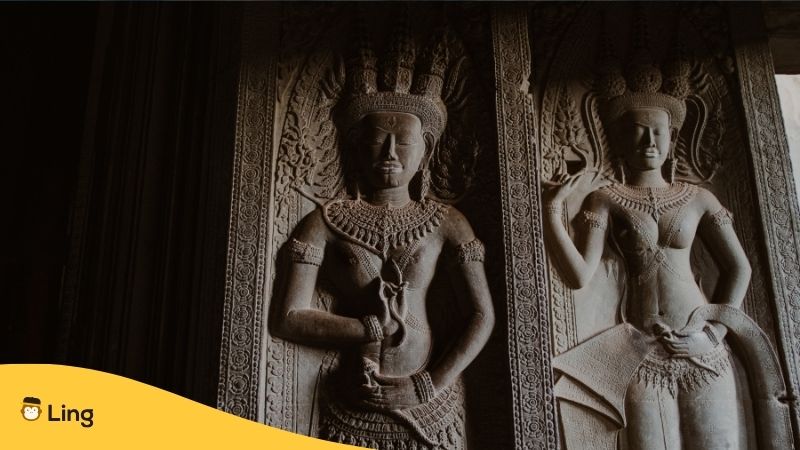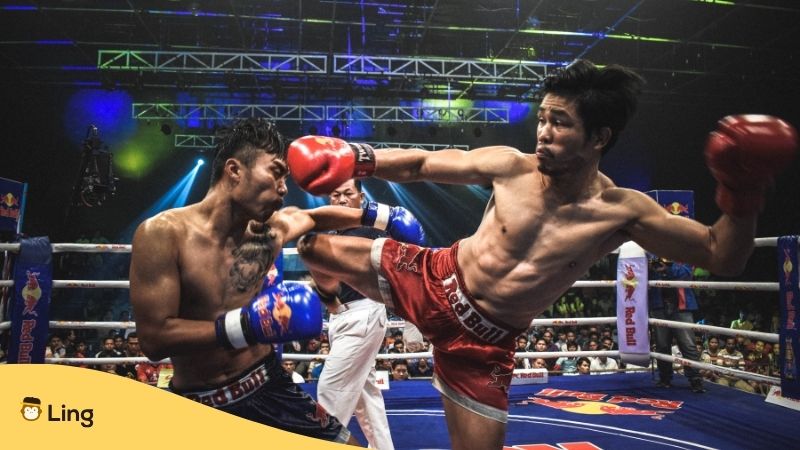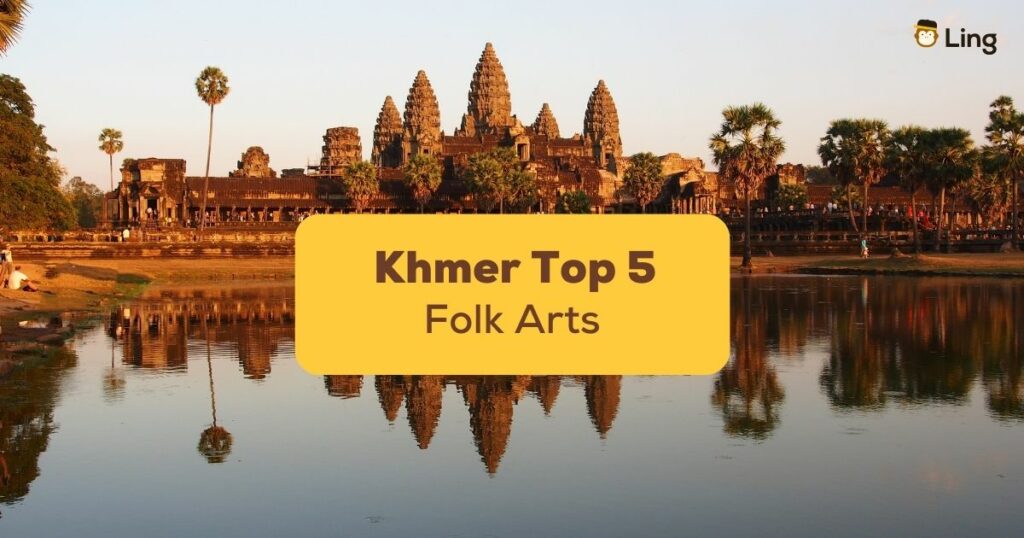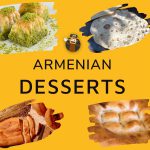Cambodia is a quaint little country tucked away like a gem in the heart of the Southeast Asian region. It has a fascinating culture and mesmerizing art traditions and in this we’ll take a laid-back journey through time to uncover how these vibrant Cambodian traditions have transformed and adapted to the changing tides of history. From ancient roots to modern interpretations, we’ll explore the twists and turns of Khmer folk arts’ fascinating evolution.
Choosing the Khmer top 5 folk arts is a tricky task and one that might cause some controversy. However, that is what we are going to try and accomplish in this piece.
Khmer Top 5 Folk Arts
Here is our pick of the five Khmer folk arts to see, hear, or try before you die:
Apsara Dance – Apsara Robam (របាំទេពអប្សរា)
The Apsara (អប្សរា) or “Absarea” dance is one of Cambodia’s most iconic and cherished forms of traditional performing arts. Rooted in the ancient Khmer civilization, this classical dance is characterized by graceful movements, intricate hand gestures, and elaborate costumes. Apsara dancers, traditionally women, depict celestial nymphs from Hindu mythology, and their performances are a stunning blend of artistry, storytelling, and spirituality.
The Apsara dance is a testament to Cambodia’s deep connection to Hinduism and Buddhism, as it often depicts scenes from these religions. Despite the devastating impact of the Khmer Rouge regime in the 1970s, which aimed to eradicate artistic traditions and wipe out all aspects of traditional Khmer art, Apsara dance has survived and experienced a remarkable resurgence in recent years.
Today, visitors to Cambodia can enjoy Apsara folk dance performances in various venues, such as restaurants and cultural centers in cities like Siem Reap and Phnom Penh. Those who don’t get to see the Apsara dancers in the flesh can marvel at the depictions and carvings of this and other fine arts in ancient and modern temple architecture at sites like Angkor Wat (អង្គរវត្).

Khmer Shadow Theatre – Lakhaon Nang Sbek (ល្ខោនណាំងស្បែក)
Cambodian shadow puppetry is a folk art that combines storytelling, music, and the intricate craftsmanship of large leather puppets. This traditional art form has a long history in Cambodian art and Khmer culture, dating back to the Angkor era (9th to 15th centuries). Sbek Thom (លាក់ស្បែកធំ) “large leather hide” performances typically narrate stories from the Reamker, an epic poem based on the Ramayana.
What sets Sbek Thom apart is its large, articulated puppets that can measure up to two meters in height. Skilled puppeteers manipulate these puppets behind a backlit screen, creating striking silhouettes that dance and tell stories. The storytelling aspect often includes moral lessons and local folklore, making Sbek Thom an educational and entertaining experience.
While Sbek Thom faced a decline during the Khmer Rouge era, efforts have been made to revive this cherished tradition. Today, there are workshops and performances that introduce both locals and tourists to the art of shadow puppetry, ensuring its survival for future generations.
Apsara Dance Of The Royal Ballet – Robam Tep Apsara (របាំទេពអប្សរា)
Robam Tep Apsara (literally, ‘Dance of the Apsara Divinities’), also known as the Apsara Dance of the Royal Ballet, is a refined and highly stylized dance that is closely associated with the Cambodian royal court. This form of dance exemplifies the grace and elegance of the Apsara folk dances, with intricate hand movements, ornate tightly fitted costumes, and elaborate headdresses.
The Royal Ballet of Cambodia, responsible for preserving and performing Khmer traditional arts such as this in modern Cambodia, was founded in the mid-20th century by Queen Sisowath Kossamak and later led by Princess Norodom Buppha Devi. The Robam Tep Apsara is a captivating example of traditional Cambodian art and a symbol of Cambodia’s royal heritage.
While the Apsara Dance we mentioned earlier is more accessible to the public, Robam Tep Apsara is a rarer and more exclusive art form, often performed during special events, ceremonies, and functions at the royal palace. Its preservation is a testament to a commitment to safeguarding traditional Cambodian arts.
Ensemble – Pin Peat (ពិណពាទ្យ)
Pin Peat is a traditional Cambodian music ensemble that plays an integral role in various forms of performing arts, including classical dance and theater. This unique musical tradition features a combination of wind and percussion instruments, creating a distinct and captivating sound.
The Pin Peat ensemble typically includes instruments such as the xylophone-like roneat (រនាត), various drums like the skor thom (ស្គរធំ) and samphor (សំភោរ), cymbals, and bamboo flutes. Each instrument has its specific role in the ensemble, contributing to the overall harmony of the music.
Pin Peat music accompanies many traditional Cambodian ceremonies and performances, from classical dance to religious rituals.

Cambodian Martial Art – Bokator (ល្បុក្កតោ)
An ancient martial art dating back to before the days of Angkor, Bokator is a fighting system the Khmer army used on the battlefield when close-quarter combat was required. Although Bokator has become a blanket term for all Khmer martial arts, it actually refers to a rather specific style of hand-to-hand combat in which certain weapons were used. Much like the Muay Thai and Muay Boran fighting styles used in neighboring Thailand, Bokator employs body parts including the shins, knees, and elbows to devastating effect against an opponent. The name is derived from “labokatao”, which means “to pound a lion”.
Legend has it that 2,000 years ago a lion attacked a village and one of the villagers faced the creature unarmed killing the beast with a single knee strike and a new form of fighting was born. As with practically everything else under Pol Pot’s Khmer Rouge, the practice of Bokator was outlawed and those involved in traditional Khmer arts were put to death. During the subsequent Vietnamese occupation of Cambodia, the martial art was also strictly forbidden.
Since the fall of the Khmer Rouge and the end of the occupation, Bokator has gingerly crept back into the country of its birth and the first-ever national Bokator competition was held in Phnom Penh at the Olympic Stadium, in 2006.
Learn More About Khmer Folk Arts & Cambodian Culture With Ling
Learning a language like Khmer is so much more rewarding when you also learn about Cambodia’s culture. As well as covering everything you will need to master Khmer. The Ling app has hundreds of blogs on its website like this one that dive into Cambodia’s history, its people and its incredible culture.
And if you like to traverse a little further into the Khmer language, you are more than welcome to download the Ling app at Google Play or the App Store. Not only will you be greeted with a fun and engaging learning experience but will also be assisted at every step on the way by its technically advanced feature and user-friendly interface. So, download the Ling app now!

































































